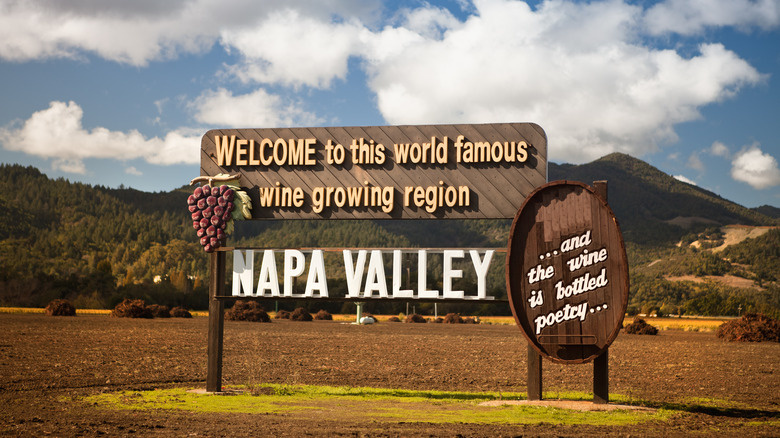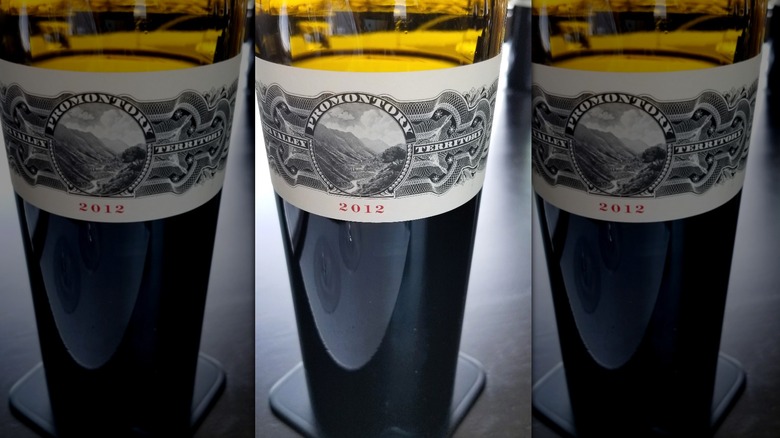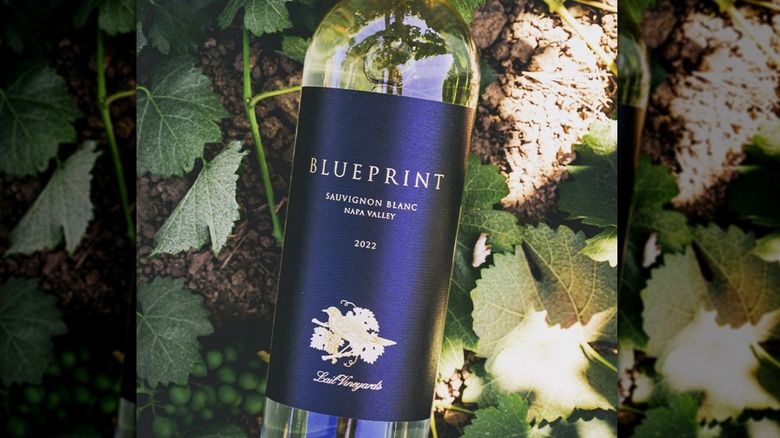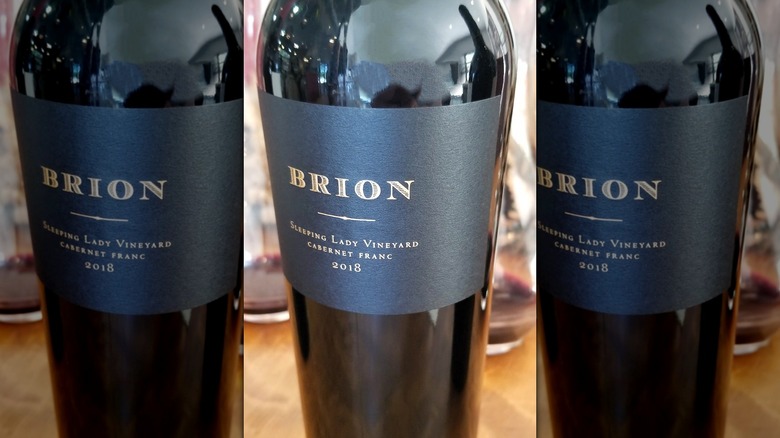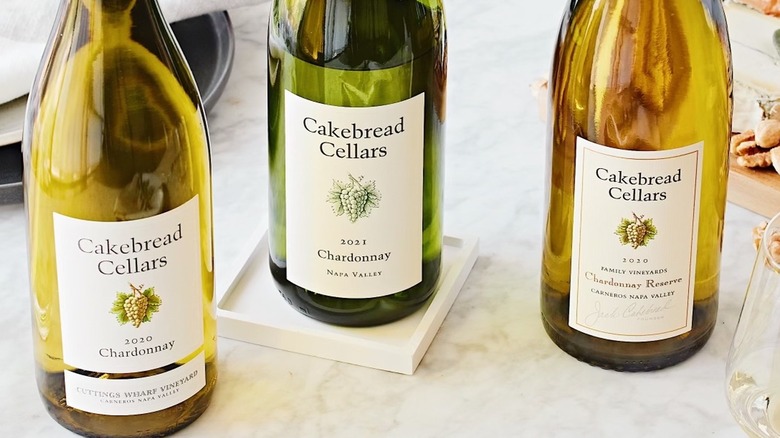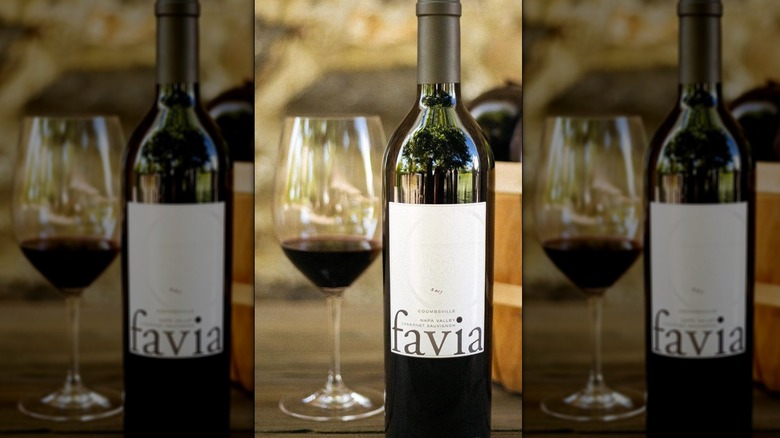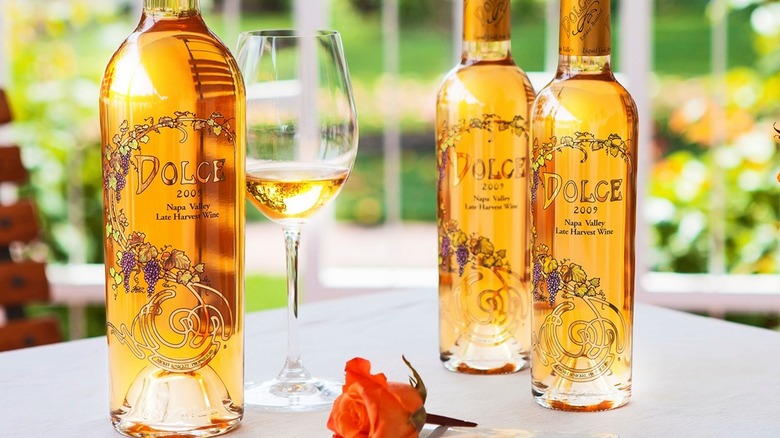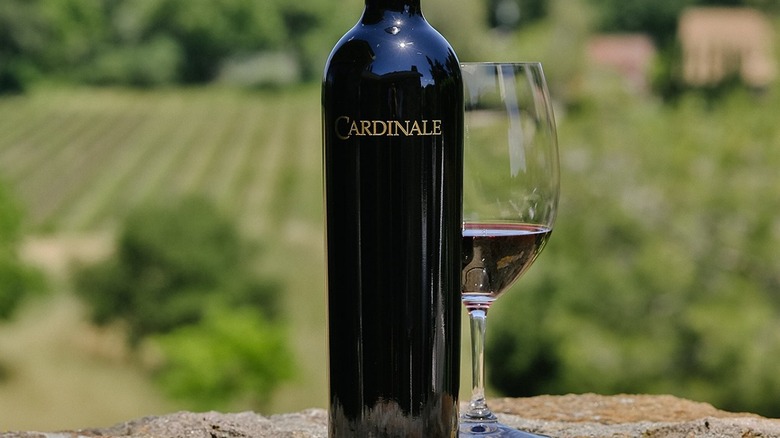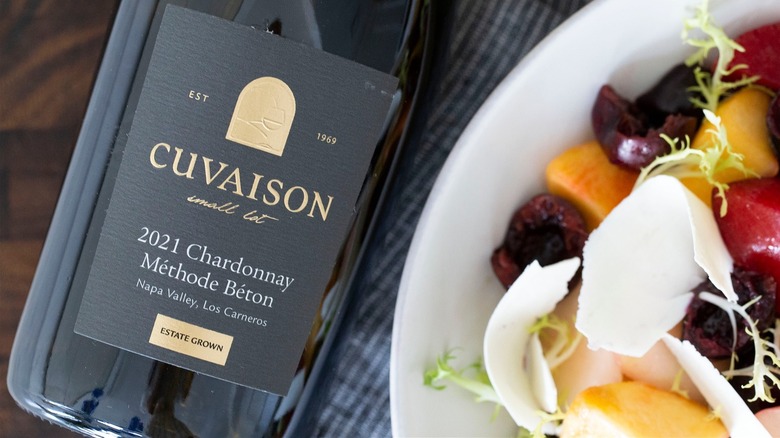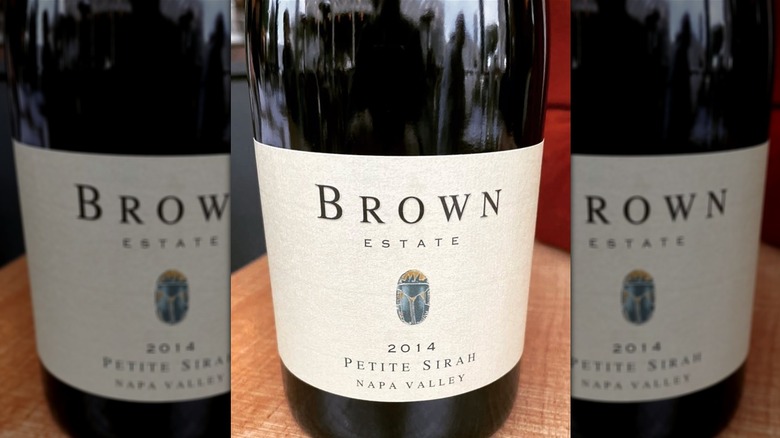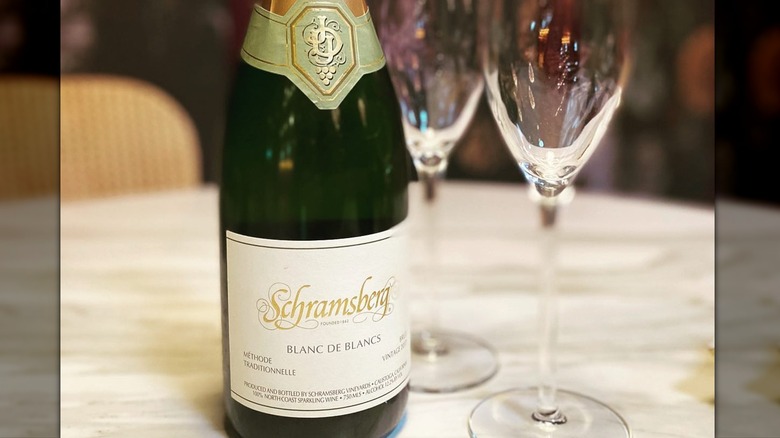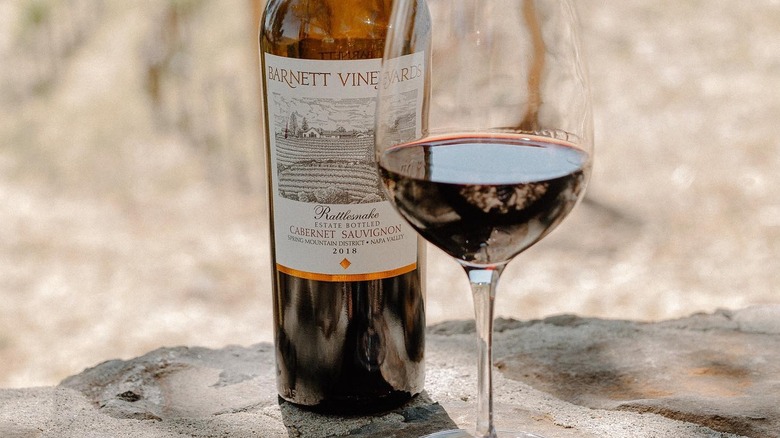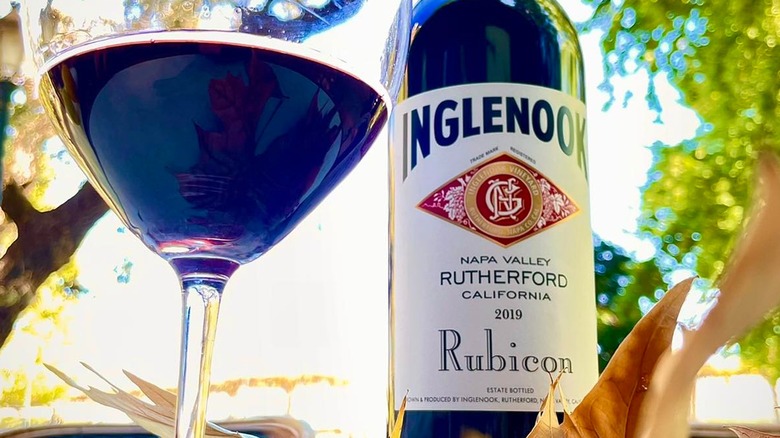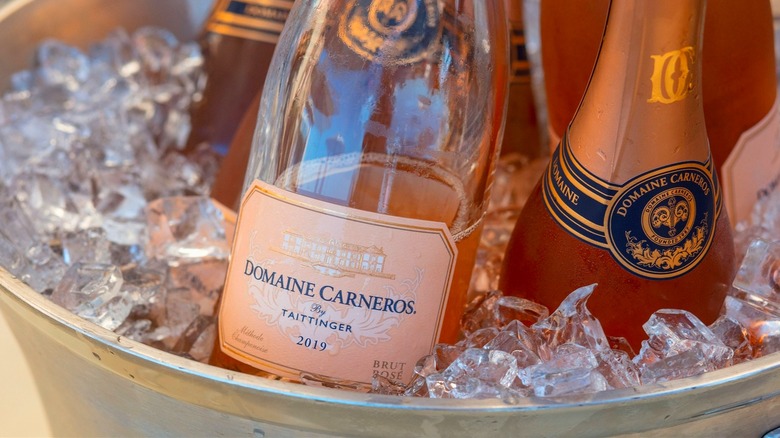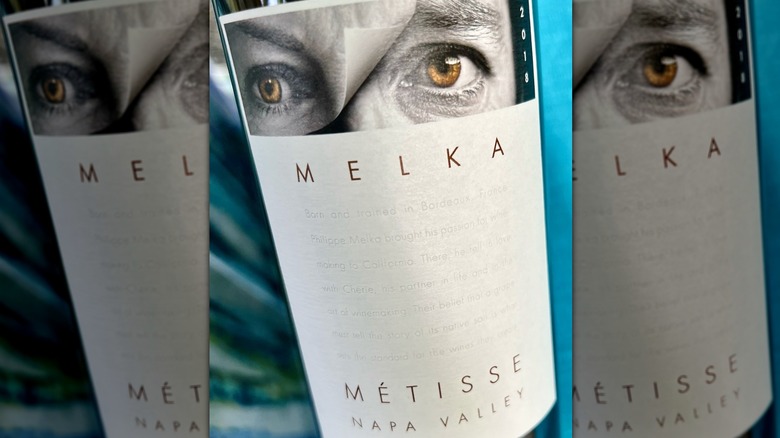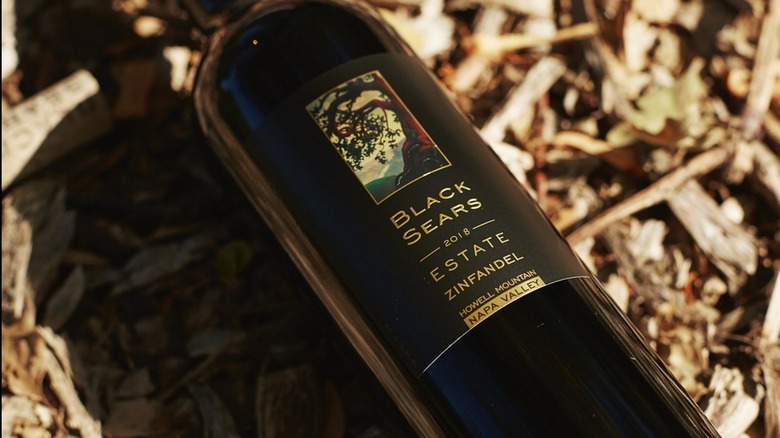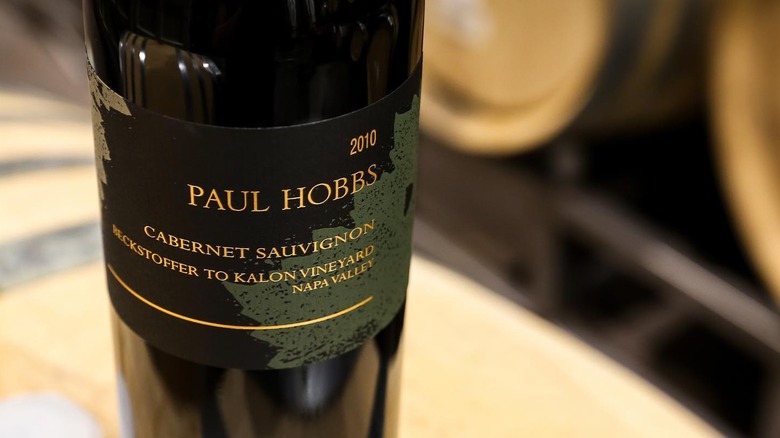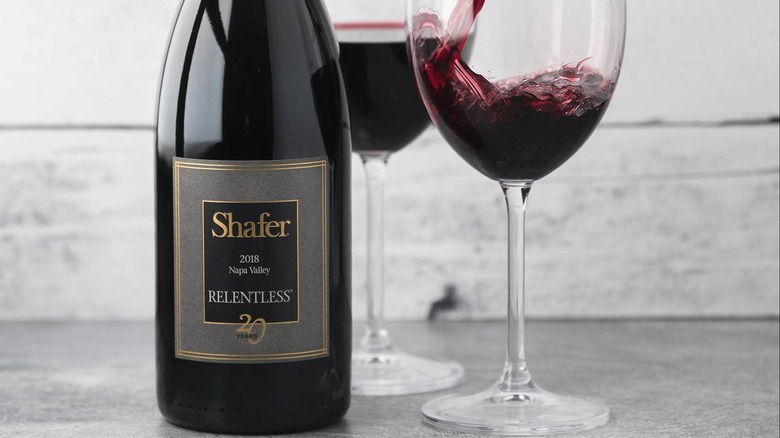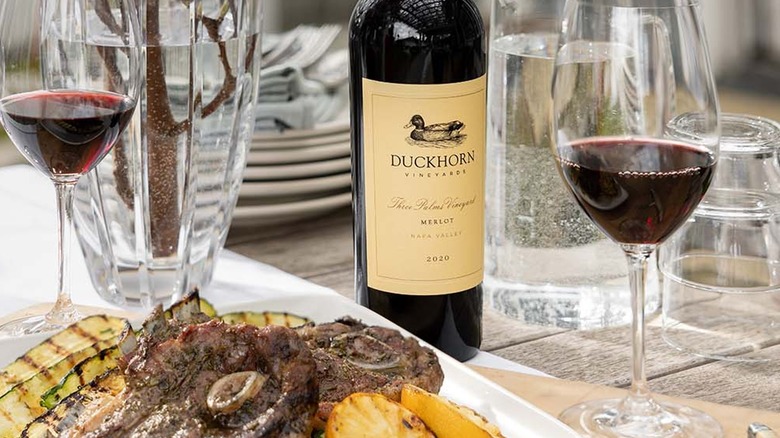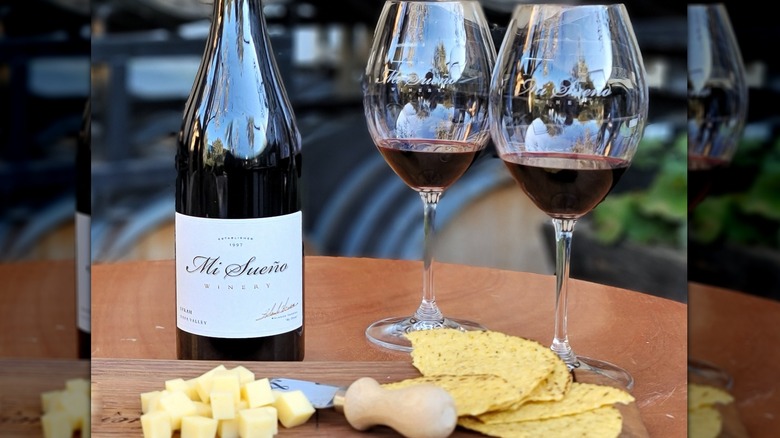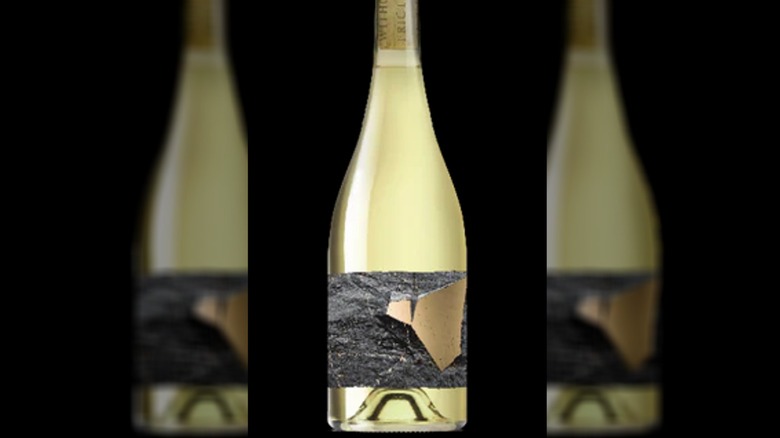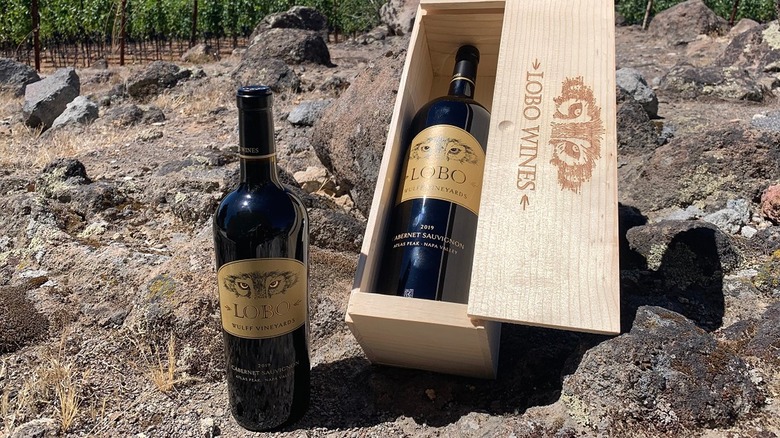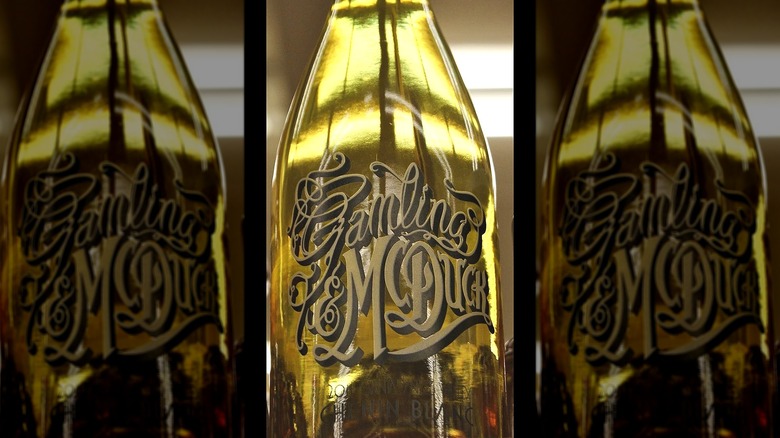22 Napa Wines That Should Be On Your Radar
Napa Valley is arguably the finest wine-growing region in America. According to a recent 2023 Direct-to-Consumer Wine Report, the average cost of a bottle of wine from Napa is over $100, almost double that of a bottle from California's other popular wine regions of Sonoma, Paso Robles, and Santa Barbara.
Sitting between the Mayacamas and the Vaca Mountains ranges in Northern California, Napa Valley is a 30-mile-long region with a range of microclimates, soil types, and elevations. Each of these contributes to the terroir that makes Napa unique. Cabernet sauvignon is the most widely planted variety in Napa. However, some winemakers have found success showcasing lesser-known grapes, particularly ones that can handle the state's continual heat and drought conditions
Today, there are over 400 wineries in the county. You can visit properties dating back to the mid-1800s to modern operations from edgy, emerging winemakers. We spoke with several of these winemakers and owners, each creating remarkable selections from the valley's premium fruit. These and a dozen others are making worthwhile wines that should be on your radar. Here are 22 Napa Valley wines worth noting.
Promontory
In the 1980s, Bill Harlan (of the cult status Harlan and Bond Wines) found a rustic pocket of Oakville land not far from his Harlan Estate that was relatively untouched and completely untamed. Looking at its characteristics, Harlan believed it would produce some of the finest wines in Napa. It would take Harlan almost 30 years to acquire the land. Once he did, he called upon his son, Will Harlan, to manage the property, ushering in the next generation.
Promontory is an expressive cabernet sauvignon-based wine. The winery employs the use of 820-gallon foudre casks to age the wine. The size of the barrels ensures minimal oak influence on the wine, allowing the fruit to shine. The result is a sumptuous and seductive wine that harmoniously integrates chewy tannin, zesty acidity, and concentrated fruit flavors.
Lail Vineyards Blueprint Sauvignon Blanc
If Napa Valley has a royal family, Robin Lail is a leading member. She spent her childhood at her family's Inglenook Estate in Rutherford. She began Merryvale Vineyards with Bill Harlan, Dominus Estate with Christian Moueix, and co-founder of Lail Vineyards with her daughters, Erin and Shannon. Lail believes in protecting the legacy of her family and the valley, namely its wine and agriculture. Her dedication to the environment has led Lail Vineyards to donate 10% of the online sale proceeds from its Blueprint wines to organizations fighting climate change.
We spoke with Robin Lail regarding the donations. "It is of the utmost importance for us to take every action we can to help organizations focusing on climate solutions," Lail says. "Every action counts!" Lail Blueprint Sauvignon Blanc is vibrant, elegant, and expressive, much like Lail herself.
Brion Sleeping Lady Vineyard Cabernet Franc
Cabernet sauvignon is a hybrid blend of cabernet franc and sauvignon blanc. The combination creates a powerful, robust variety that gets most of the attention in Napa. Cabernet franc, on the other hand, is often relegated to Bordeaux-style blends. However, when care is given to producing single variety cabernet franc, it can create an ethereal, exquisite wine. Brion winemaker, Julien Fayard, accomplishes this with Brion Sleeping Lady Vineyard Cabernet Franc.
In speaking with Fayard regarding the wine, he said, "While cabernet sauvignon has been the benchmark for the search of terroir and site expressions in Napa Valley, cabernet franc brings another lens to look at the Sleeping Lady terroir with elevated aromatics and brighter acidity." The wine has energy and an intriguing savory note. Its flavors layer sweet tobacco, red berries, and woody herbs.
Cakebread Cellars Chardonnay
In 1972 Jack and Dolores Cakebread bought a small piece of Napa land with a dream of making wine. Their first endeavor was producing a Napa Valley chardonnay in 1973, which Cakebread sold to a nearby Yountville retailer. Today, Cakebread chardonnay remains one of the top restaurant selections nationwide, likely because it is known for its reliable consistency. The wine showcases classic traditions while integrating modern green initiatives and technological innovations.
The Napa Valley chardonnay uses Carneros estate fruit, revealing layers of golden apple, peach, and melon flavors with hints of vanilla. Though the wine has weight, there is also bright freshness and a mineral-rich layer of wet stone, ensuring a well-rounded, inviting palate. Enjoy it with a classic roast chicken recipe.
Favia Coombsville Cabernet Sauvignon
Esteemed winemaker Andy Erickson and his wife, viticulturist Annie Favia, are a golden couple of Napa Valley wines. Each brings skill and craftsmanship to the table, Erickson as winemaker for cult-status brands, like Screaming Eagle and Ovid. Favia spent a decade working with David Abreu, one of Napa's most respected viticulturists.
After years of making wine together in their St. Helena home's basement, Erickson and Favia launched their joint effort to the public in 2003, Favia Wines. In 2014, they moved to the historic Cabone property in Coombsville. Focusing on biodynamic farming and non-interventionist winemaking, the couple crafts distinctive wines that reflect their pedigree. Favia's Coombsville Cabernet Sauvignon is grown in rocky volcanic soils, giving the wine an Old World European style. Its flavors include black cherry, wet leaves, crushed stone, and graphite.
Far Niente Dolce
Dolce's late harvest wine is Napa Valley's sweet elixir of liquid gold. The wine blends semillon and sauvignon blanc, growing at the base of the Vaca Mountains in Coombsville. A layer of fog engulfs the vineyard from the evening to mid-day, allowing botrytis cinerea, or gray mold, to form over the grapes. This botrytis is called "Noble Rot" and causes the fruit's water to evaporate, concentrating the grape's sugars and flavors.
Picking late-harvest fruit usually occurs several months after the harvest for still wine production. Dolce's fermentation takes two months, after which the wine ages in new French oak for two years. The resulting wine has spiced honey, dried apricot, and vanilla syrup flavors. Pair Dolce with sweet or savory dishes, like Gorgonzola ravioli, foie gras, or chocolate soufflé.
Cardinale
Every wine is a combination of something, whether it be different varieties, vineyards, or clones. Understanding how to bring those parts together takes skill, taste, and craftsmanship. Cardinale winemaker, Christopher Carpenter, masters these qualities.Carpenter shared his thoughts on making the prestigious selection from Jackson Family Wines with us. He has been Cardinale's winemaker since 2001, imparting his style to the ever-evolving blend.
"My goal with Cardinale is to create an expression of Napa Valley guided by each year's vintage character," Carpenter says "I typically start with 30-40 individual wine lots and have the freedom to blend as I see fit." Carpenter calls each vintage a symphony, showcasing the valley's complete story rather than that of a single parcel. The result is a balanced, harmonious wine with authentic Napa Valley character.
Cuvaison Chardonnay Méthode Béton
Located in southern Napa in the rolling hills of Los Carneros, Cuvaison crafts cool-climate chardonnay and pinot noir wines. Winemaker Steve Rogstad believes wine is made in the vineyard, allowing the essence of the place to shine. However, he is also constantly curious to try new things, building on the winery's legacy.
Cuvaison Méthode Béton Chardonnay was born from this curiosity. The wine's production is with concrete eggs where the lees (yeasts) in the fermenting and aging wine are constantly in motion. This motion adds texture and creaminess while preserving the variety's aroma and energy. When we asked Rogstad about its inception, he shared, "Our Méthode Béton offers a really compelling meeting point between the sleek poise and purity of unoaked wines and the depth and luxuriousness of barrel-aged wines." It is one of the most delicious expressions of Napa chardonnay.
Brown Petite Sirah
In 1980 Dr. David Brown and his wife, Dr. Marcela Brown, purchased a plot of land in Napa Valley. They planted 10 acres of vines, selling the fruit to established wineries. In 1996, their children, David and Deneen, had another idea. After years of tasting wines made from their quality grapes, they knew they could create something unique with their estate fruit, launching Brown Estates. It is one of the growing number of black-owned wineries in the country.
Today the winery is known for its zinfandel; however, we love Brown Estate Petite Sirah. The powerful and robust variety has inky tannin and fleshy acidity. The wine is aged for a year in new American oak barrels, lending spiced coconut flavors to the variety's earthy characteristics.
Schramsberg Blanc de Blancs
In 1965, the Davies family produced the first bottles of Schramsberg Blanc de Blancs sparkling wine. They were the first winery in America to make sparkling wine with chardonnay fruit commercially. President Nixon served the wine at the 1972 "Toast to Peace" state dinner with China. This event gained the winery international recognition and a spot among the wines poured by future administrations, including when President Ford hosted Queen Elizabeth II and when Ronald Reagan hosted Prime Minister Margaret Thatcher.
Using a traditional style of Champagne production, the Blanc de Blancs 100% chardonnay sparkling wine ages in the bottle for two years. It develops a rich, round palate during this time. Brioche, marzipan, and citrus aromas lead to golden apple and honeycomb flavors, perfect with seared scallops recipe.
Barnett Vineyards Rattlesnake Cabernet Sauvignon
In 1983, Hal and Fiona Barnett planted a vineyard at one of the highest points on top of Spring Mountain. They named the vineyard Rattlesnake Hill after discovering 33 rattlesnakes in a central clearing. With an elevation of 2,050 feet, the terraced vineyard has some of the valley's steepest slopes. The vineyard lies above the fog line, where grapes enjoy up to three hours of additional sunlight daily compared to vineyards below the fog.
The elevation's temperatures remain cool throughout the growing season, allowing grapes to ripen slowly. The result is highly concentrated, structured fruit with elegant sophistication. The wine ages 22 months in French oak, softening the tannins while lending layers of toasted spice and dark chocolate.
Inglenook Rubicon
Rubicon is the signature red blend from one of Napa's most distinguished, historic wineries, Inglenook. Located in the Rutherford district, Inglenook was established in 1879 by Gustave Niebaum, the great-granduncle of Robin Lail. It quickly became one of the ground-breaking producers in Napa Valley. This legacy is carried under the direction of owners Eleanor and Francis Ford Coppola and their families.
The first vintage of Rubicon came in 1978, shortly after the Coppolas purchased the property. The goal was to create a wine of the same quality and notoriety as those achieved under Niebaum and his successor, John Daniel, Jr., Lail's father. Rubicon masters this task with ease. The cabernet sauvignon-dominant blend from organically farmed Rutherford estate fruit combines power and grace, tannin and acid, and fruit with earth. This wine deserves discussion and contemplation, appreciating its nuanced elegance.
Domaine Carneros Brut Rosé
Champagne Taittinger's family winery, Domaine Carneros, produces premium, traditional method sparkling wine from sustainably farmed Carneros fruit. Cooling breezes off the San Pablo Bay keep fruit crisp, healthy, and fresh, with bright acidity.
The winery's brut rosé blends 58% pinot noir with 42% chardonnay, lending wild strawberry, mandarin, and red apple notes that linger with blanched almond, custard, and subtle forest floor and floral notes. Including chardonnay in the blend lends structure to the wine, balanced with the delicate richness of pinot noir. The wine is crafted in the traditional method style, aging for three years on the lees. The aging gives the wine creaminess, enhancing its overall character. It is delicious paired with anything from slow-roasted pork belly to strawberry tarts.
Melka Estates Métisse Montbleau Vineyard Cabernet Sauvignon
Bordeaux-born and trained Philippe Melka is one of the region's most celebrated winemakers. He lends his talents as consulting winemaker and head of Atelier Melka to a dozen of Napa's premium producers, including Lail, Brand, and Dana Estates, crafting expressive wines that showcase the vision of his winery partners. All of his client's wines are delicious. However, Melka Estates is the wine that tells his personal story. It was created in partnership with his winemaker wife, Cherie.
From estate fruit growing on the slopes of Glass Mountain, Melka Metisse Montbleau Vineyard cabernet sauvignon is a bold, inky wine with character. The vineyard receives full sunlight throughout the day, creating robust, well-ripened fruit. This fruit produces bold wines with earthy dried tobacco, pencil lead, and black cherry, delicious with braised short ribs.
Black Sears Zinfandel
Nestled in the volcanic rocks on the top of Howell Mountain, Black Sears produces luscious wines from organic and biodynamically grown fruit. The vineyard is one of the highest in the county, at 2,400 feet above sea level. It sits well above the fog line to ensure a long growing season with warm days and cool nights, producing full-bodied, concentrated wines.
The first plantings on the property were to zinfandel vines in 1975. Today, well-respected winemaker, Thomas Rivers Brown, transforms these old zinfandel vines into luscious, lively, multi-layered wines with a distinct character showcasing the rugged mountain. The wine is fruit-forward, with blackberry, black plum, and boysenberry. However, it is not jammy. Instead, it is the perfect combination of refinement with rusticity.
Paul Hobbs Beckstoffer To Kalon Vineyard Cabernet Sauvignon
Winemaker Paul Hobbs grew up on a family-run orchard in upstate New York, learning how the terroir could affect the fruit, changing flavor. He has carried these ideas throughout his career, crafting vineyard-specific wines that tell the story of the land. Oakville's pristine To Kalon Vineyard is one vineyard he has worked with since the inaugural vintage of Opus One.
Hobbs purchases the fruit from one of California's most distinguished vintners, Andy Beckstoffer. Beckstoffer's exacting vineyard management results in exquisite fruit year after year. Beckstoffer has planted To Kalon with an array of cabernet sauvignon clones suited to the vineyard's range of soils. The combination results in a multi-dimensional wine with opulence. It layers blue and black fruit with sandalwood and graphite. The ripe, plush tannins allow enjoyment now or decades later.
Shafer Vineyards Relentless
Shafer Relentless began as a field blend of syrah and petite sirah. Shafer winemaker Elias Fernandez shared with us that this wine recognizes the old-school winemakers of the valley. Those growing grapes in Napa for generations. Their homemade wine for personal consumption was often petite sirah. Shafer's Relentless wine honors the older generations while symbolizing an undeterrable pursuit of perfection.
Today, the wine includes small amounts of structured, textural, tannic petite sirah that blends with savory, meaty, supple syrah. Its fruit grows in the foothills of the Vaca Mountains in Napa's Stags Leap District. It ages 30 months in new French oak, creating a muscular and bold combination of fruit, spice, and oak.
Duckhorn Three Palms Vineyard Merlot
In the mid-1970s, Duckhorn Vineyard's founders, Dan and Margaret Duckhorn, hung their hats on merlot in the land of cabernet sauvignon. They remained dedicated to the variety through the Sideways years when the grape fell out of favor with many New World producers.
We asked Duckhorn winemaker Renee Ary about the winery's relationship with the grape. "Dan and Margaret Duckhorn's passion for the elegance and versatility of merlot has consistently influenced every vintage at Duckhorn Vineyards," Ary says. "We take pride in being the first U.S. winery to showcase merlot as a luxury standalone variety." She adds that the name Duckhorn is synonymous with high-quality merlot production.
Duckhorn's historic Three Palms Vineyard Merlot was named the number-one wine in the world by Wine Spectator in 2017. The 2019 release is complex and concentrated, with ripe red and black fruit, crushed stone, and dark chocolate.
Mi Sueno Syrah
Rolando Herrera arrived in the U.S. as a teenager from Mexico. He started as a dishwasher at Auberge du Soliel. With passion and determination, Herrera spent the next decade working with some of Napa's finest wineries, including as cellar master for Warren Winiarski at Stag's Leap Wine Cellars, winemaker for Vine Cliff, and as Director of Winemaking for Paul Hobbs Consulting.
In 1997, Herrera began Mi Sueño Winery, Spanish for my dream, with life and business partner Lorena Robledo producing 200 cases of chardonnay. Mi Sueno Syrah showcases everything Herrera and Robledo love about wine: It is bold and ripe with robust flavor and character. While intense, the wine has balance, ideal with a slow-braised lamb shank recipe.
Prisoner Wine Company Friction
Prisoner Wine Company is one of the newest additions to the valley's winery scene. Though The Prisoner red blend wine has been around for over 20 years, the winery opened its tasting room doors to welcoming guests only a few years ago. Here the winery showcases a melange of unusual, outside-the-box offerings beyond its signature label, including its viognier wine, Friction.
From hand-harvested fruit grown in Oak Knoll's Rodger's Vineyard, the wine leaps from the glass with peach, lemon blossom, and apricot aromas. The palate bursts with racy, refreshing acidity, with layers of fresh cinnamon, stone fruit, and citrus. The zestiness lifts the wine's natural richness, making it a delicious salmon pairing. Or, try it with a sweet and spicy Indian stew recipe.
Lobo Atlas Peak Cabernet Sauvignon
One of Napa's most rugged regions is Atlas Peak. It has some of the region's lowest rainfalls, steepest slopes, and porous volcanic soils that do not retain water. Farming here is extremely difficult. However, it also has significant temperature swings from day to night. These swings allow grapes to ripen during the growing season while maintaining freshness.
Sitting at 1,350 feet elevation, the four-acre, hand-farmed Villa Lobos Vineyard produces Lobos Estate signature Cabernet Sauvignon. The region's rustic earthiness shines through the wine. It combines savory spices and dried herbs with wild blackberries, graphite, and leather. Victoria Coleman, one of California's few black female winemakers, crafts the selection. She was the first black female to graduate from the prestigious enology/viticulture program at U.C. Davis.
Gamling and McDuck Henry's Vineyard Chenin Blanc
Minnesota natives Adam McClary and Gabrielle Shaffer arrived in Napa Valley in 2008, dreaming of producing premium wines. Since their arrival, their focus has been on chenin blanc and cabernet franc, finding inspiration in the wines of Loire Valley.
Their Henry's Vineyard Chenin Blanc is sourced from one of the oldest vineyards growing the variety in Napa. Nestled on the backside of Howell Mountain in Pope Valley, chenin blanc has grown in Henry's Vineyard since the late 1960s. Though it was a common variety at the time, very little exists in Napa today. Still, these old, gnarly, heritage vines produce concentrated berries with lively acidity that melds with luscious richness. Pair with spicy, savory a shrimp pad Thai recipe.
